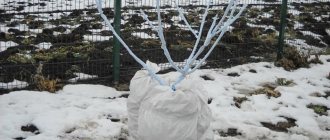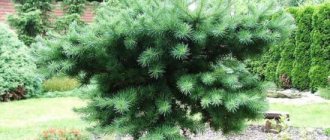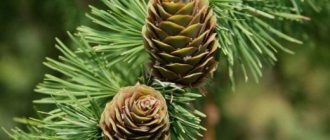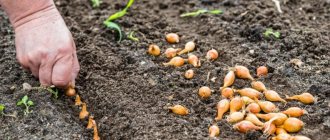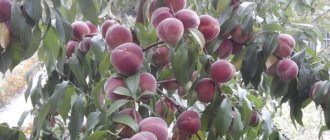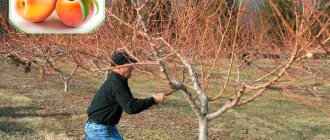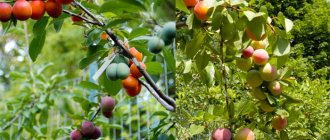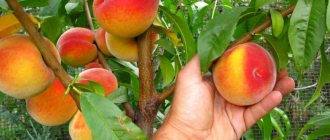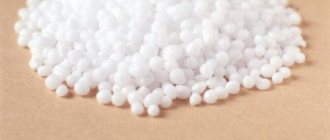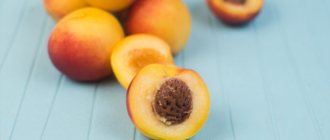Why insulate peaches for the winter?
Previously, you had to go to the Crimea or the Caucasus to buy peaches, but today these delicious fruits can be grown in cooler regions. Competent selection and special agricultural technology helped to achieve this.
Despite the cold-resistant varieties bred by breeders, the southern tree still needs to be insulated. If you do not cover the peach for the winter, the tree will probably freeze at the first severe frost. Peach trees, regardless of variety, are demanding in terms of growing conditions and require delicate handling.
On a note! If cold weather approaches gradually, then the critical temperature for peach is the range -23...-24°C. If the temperature drops sharply, the tree can suffer even at -16...-17°C.
Why you need to insulate your peach for the winter:
- does not tolerate severe frosts characteristic of the middle zone;
- afraid of sudden cold snaps;
- reacts negatively to winter storms;
- a frozen tree will not give a good harvest, the yield will drop - the fruits will be small or there will be none at all;
- protection from the negative effects of ultraviolet rays;
- protection from rodents;
- the tree may die.
Timing and methods of shelter
The timing of peach insulation for the winter depends on the climatic conditions in the region and on specific weather conditions. But before starting to insulate the tree, gardeners prepare the peach for winter.
Peach trees require special care in the fall. The main autumn activities are pruning and spraying. Having completed all the preparatory work, gardeners begin insulation.
They begin to insulate a tree under the following conditions:
- the leaves on the trees have completely fallen;
- The first frost hit.
Typically, preparatory activities take place from the end of September to the beginning of October. Adjusted for region and weather conditions. Warming is carried out 2-3 weeks later.
On a note!
To protect the peach tree from fungal infections, in the fall it must be sprayed with 3% Bordeaux mixture (from 2 liters per tree) or another copper-containing preparation.
An insulated peach has every chance of surviving the winter safely. The main thing is to choose the right method of shelter, corresponding to the level of threats, and remove the insulation in time. If you delay in “uncorking” in the spring, the tree may rot.
The shelter method is selected taking into account the regional climate. Options for covering seedlings and mature trees:
- Warming the roots with humus. Instead of soil, a peat-humus mixture is used for hilling. The soil freezes quickly. And if the winter is not snowy, then the protective layer may not be enough and the roots will freeze. Other materials can be used for mulch.
- Cover with spruce branches or corn stalks. These materials allow you to create a well-ventilated protective layer. Such insulation saves the roots and part of the trunk from cold, rain, sleet, and wind.
- Dropping to the grafting level. This method is used to preserve seedlings. First, they dig a hole about half a meter deep, place seedlings in it at an angle of 45 degrees and dig in with soil. A prerequisite is that the seedlings must be positioned with their tops facing south.
- Thermos style shelter. The covering material is placed around the trunk, leaving a gap between them. The empty space is filled with sawdust. The structure is covered with a film on top to protect the sawdust from getting wet.
- Construction of a “hut”. The tree must be completely covered. All parts of the tree, including the crown, should be in the hut. First, a frame is built, and then covering material is thrown over it. To make the frame, metal hollow tubes or wooden planks are used.
- Agrofibre wrap. The trunk and crown of the tree are wrapped with covering material. To make it easier to wrap the tree, the crown is pre-tied with twine.
A video about covering a peach with spunbond will help you master the insulation technique:
Peach pruning in autumn
The removal of peach branches that have grown over the period must be carried out in order to increase the future yield so that the crop can favorably survive a strong drop in temperature.
Peach is a plant that requires pruning at different times of the year:
- Spring - carried out “on a rose bud” . Old trees require a rejuvenation procedure. Young seedlings 2-3 years old undergo pruning to form a crown. Restoring is also advisable - to cut off all frost-damaged shoots.
- Summer - thinning of grown young shoots , which contribute to the thickening of skeletal branches. Removing dry branches that were missed in the spring and damaged by pests and diseases.
- Autumn – sanitary cleaning of diseased sprouts infested with pests. Removing branches that have broken off due to weather conditions and the weight of the harvest.
Each period of eliminating excess growth is important in its own way. For high-quality growth and good fruiting, you need to monitor the condition of the fruit tree throughout the year .
It is recommended to carry out autumn pruning of peach immediately after the harvest is harvested , but no later than mid-October. In addition, you need to choose a dry, windless and sunny day. In damp weather conditions, the atmosphere has a favorable effect on the attachment of infections and bacteria to fresh cuts.
Note! Pruning peach trees in the fall is necessary to properly prepare the plant for winter. In addition, all root stepsons are eliminated. They can overwinter harmful insects that can crawl from an infected seedling to a healthy peach.
Removal of excess growth is carried out only with clean garden tools disinfected with potassium permanganate . For different branches, a specific device is taken: a garden saw, a knife and a pruning shears.
The autumn peach pruning scheme includes the following procedures:
- The upper branch is cut off at the very base.
- The upper branches from the side are removed along the top, leaving 2-3 eyes on the lower shoots.
- It is necessary to thoroughly thin out the shoots growing inward so that the skeletal branches are not thickened, and future fruits have space to grow and be saturated with sunlight.
- Diseased, dry or mechanically broken shoots are removed completely.
- Thin and long green shoots that have not yet ripened need to be shortened by 50%.
A young peach seedling , planted for permanent residence, is subject to crown formation already in the first autumn . The top of an annual peach is trimmed so that the height of the tree from the ground is 50 cm.
In the 8-10th year, it is recommended to rejuvenate the peach . To do this, carry out the following steps:
- Broken and dried branches are pruned.
- Fruiting shoots on which fruit formation is not observed must be cut off by a third of the entire length.
- Control the growth of the peach so that it does not exceed 3 meters.
- All skeletal branches need to be cut back to the level where they were at 3-5 years of age. The stump is made near a young and strong branch. It will later become a continuation of the skeletal one.
- If the forecast for the winter is disappointing, with severe frosts and heavy precipitation, it is worth removing all thin and green branches.
Important! Not all varieties need to be pruned in the same way; some require special care. It is recommended to additionally trim such types of peach as Boxer, Royal, Autumn Blush, Glory, Skif, Krasnodarets using “household” pruning.
A large number of fruit-bearing buds form on the branches of these trees. During ripening, the fruits greatly weigh down the branch and prevent each other from fully developing and being saturated with sweetness.
Shelter rules in different regions
Different regions have their own methods of sheltering. They are selected taking into account the climatic characteristics of the region. The colder the winter, the lower the temperatures and the stronger the piercing winds, the more securely the peach is covered.
Features of peach shelter by region:
- In the southern regions, insulation is limited to hilling. In areas with warm winters, it is enough to rake the soil to the tree trunk. If snow falls, rake it up to the trunk. If there is a risk of roots freezing, instead of soil, a mixture of peat and humus is raked into the tree trunk circle.
- In regions with little snowy winters and moderate frosts, the tree trunk circle is mulched with sawdust mixed with ash. The thickness of the mulch layer is 15 cm. This method of insulation is practiced in the Krasnodar Territory, Rostov Region, and the North Caucasus. Without global shelter, frost-resistant varieties can also overwinter in the Moscow region and the central zone. Less resistant varieties are wrapped.
- In Siberia and the Urals, the most extensive protection methods are used. Here the trees are completely covered using the wrapping method or frame shelters with a crown (hut). A more radical method is also used here - bending down. The tree is first bent to the ground, secured, straw or spruce branches are thrown on top, and in winter the snow is constantly raked up.
On a note!
The root system of a peach tree can be simply and effectively insulated by covering the trunk circle with plastic film.
What are the features of preparing peach for winter in individual regions?
Peach is planted not only in southern cities, but also in other parts of vast Russia. So that it can survive the winter well, different regions use unique methods of covering the tree for the winter.
By the way! There are no particular differences in covering peach for the winter among regions. So in the Urals and Siberia, as well as in the Moscow region and the Volga region, volcano huts are erected or wooden frames are installed. This method allows you to preserve the crop shoots as much as possible and preserve fruit-bearing buds.
In the Moscow region and the Volga region, some farmers do not cover their trees, and most varieties of peaches survive the winter safely. The wood does not suffer much, which cannot be said about flower buds - all of them - but a lot of them freeze. That is why gardeners have come to the conclusion that it is better to cover peaches in the middle zone for the winter.
Insulation is carried out after the first frost (-5..-10 C). For this purpose, huts are erected. Underneath them, the branches are tied with ropes to the trunk, and on top are placed blocks of wood, secured to each other with screws. Sheets of mineral wool are placed on the structure, which are covered with polyethylene on top so that the structure does not get wet by rain.
Video: covering a peach for the winter with slate
The southern side is additionally covered with slate to protect it from the bright sun. But in the spring, on the first sunny days, all insulation is removed so as not to provoke rotting.
Thus, shelter is necessary in any situation and in any frost. The greater the frost, the less likely it is for a successful outcome for the fruit crop.
Selection of material for insulation
When insulating a peach, a gardener decides two questions: what covering method to use and what material to choose for this purpose. The choice depends on which part of the tree is to be insulated.
May be interesting Spraying peach in spring against pests and diseasesPeach curl: how to treat, what to spray for curl after floweringFeatures of spring peach tree grafting
Materials for insulation:
- Underground part. To protect the soil from freezing and the roots from freezing, the tree trunk circle is insulated with peat, sawdust or ordinary soil. Less often - manure and sawdust. All these materials cope well with the functions assigned to them, they are accessible and cheap. Typically, gardeners choose the material that they have on hand.
- Aboveground part. The upper part of the tree is wrapped or covered with burlap, agrofibre, spunbond, or plastic film. Spunbond is considered the best of these materials, but its cost is higher than that of its competitors.
Advantages of spunbond:
- allows you to create a favorable microclimate under the shelter;
- can last several winters;
- This material is easy to work with.
Work order
Insulation work consists of two stages - autumn maintenance and insulation. To prepare a peach for winter, it is first trimmed, sprayed and watered, and then insulated.
The procedure for preparing peach for winter:
- Apply phosphate fertilizers. To do this, dig tree trunk circles 25 cm from the tree trunk. The depth of the grooves is 20 cm.
- Feed the tree with organic matter - mullein, peat, humus or chicken droppings.
- Carry out moisture charging. In autumn, the tree needs to be watered abundantly. Moisture prevents soil freezing, protecting roots from freezing.
- Perform sanitary pruning. Remove damaged, diseased and dry shoots. Also remove overgrown young shoots.
- Whiten the trunk to protect the bark from burns. To do this, prepare a mixture of fluff lime (2 kg), copper sulfate (250 g) and laundry soap (30 g).
- Spray the tree with lime milk. It is also recommended to treat the peach with a mixture of fungicides and insecticides to prevent disease and protect against insect pests.
- Insulate the tree. Choose the appropriate insulation method, prepare the materials and get to work.
Features of caring for peach in the fall and when preparing it for winter - general tips and recommendations
It is very important to prepare the peach for the winter and carry out appropriate care and pruning measures. All procedures are performed at various points in the fall; preparations for the first frosts should be gradually undertaken.
The following is a list of activities that should be performed before wintering peach in the fall:
- Digging up the soil near the roots - digging up the top layer is necessary to lift the lying parasitic insects out. The shovel should be immersed completely on the bayonet, while inverted clods of earth should not be loosened. The first frost will independently kill possible pests and thoroughly loosen the soil.
- Application of mineral fertilizers - for this purpose, depressions are dug 25 cm in size and no more than 30 cm in length. They should be applied according to the following scheme: phosphorus - soil layer - potassium - soil layer.
- Watering – abundant watering is not required. Moderate application of nutrient moisture is necessary in the last days of October - in the first week of November. Late irrigation can damage the roots of the crop.
- Pruning – it is recommended to carry it out from the middle of the first autumn month for a month. During this period, all types of removal of unnecessary shoots are performed.
- Whitewashing the root trunk and lower skeletal branches is necessary so that the plant does not get burned under the bright winter sun.
- Treatment of branches and trunk from pests - chemical insecticides are used.
- Insulation - for this, the trunk near the root is covered with spruce branches or wrapped in straw mixed with sunflower stems. The insulation material is tied with ropes and topped with either thick paper or burlap.
By preparing a peach in the autumn, you don’t have to worry about its condition in winter. In such conditions, the tree will overwinter well and will delight you with abundant flowering in the spring.
Wintering without shelter
Only peaches grown in the south can do without shelter. Gardeners in the temperate zone, Siberia and the Urals must necessarily insulate their trees.
If you leave a peach without shelter in regions with harsh winters:
- The branches and roots will freeze. If the tree is weak, young, or the variety is not frost-resistant, the tree may die.
- Bark burns from sunlight. The winter sun can cause damage no less than frost.
- Injury to branches due to snow and ice.
- Bark gnawing by rodents. The consequences of rodent activity depend on the degree of damage. This could be a decrease in yield, disease or death of the tree.
On a note!
You should not insulate trees if it is damp and raining outside. In such weather, all the covering material will be saturated with moisture, and it will turn from insulation into a refrigeration chamber.
Peach trees require increased attention in our latitudes. If you do not care for it and do not cover it for the winter, it is impossible to achieve good harvests. After spending half an hour insulating the tree, you can count on a harvest of juicy and large peaches.
Typical mistakes in caring for peach in the fall and when preparing it for winter
Important! Caring for the plant must be done tirelessly, its growth must be monitored, and broken and damaged branches must be removed.
If you do not perform simple operations, the peach will become overgrown, stop bearing fruit, and may freeze in winter. The following mistakes are made by gardeners:
- Untimely pruning - if you start doing it while there is foliage on the tree, the plant will suffer, lose a lot of nutritious juice and weaken the immune system.
- An untreated cut is an excellent entry point for viruses and pathogenic bacteria to house pests for the winter.
- If you do not prune damaged or diseased branches , then when the first rays of sunlight appear, the pests will attack the weakened tree with renewed vigor.
- After the tree trunk circle has been dug, there is no need to loosen the clods of earth . If you loosen them, then all the pests will again hide in the soil.
- In damp, rainy weather, you should not bother with insulation - all the material will get wet and, instead of insulation, will serve as a refrigeration chamber for the wood.
Thus, by following simple rules for caring for a peach in the fall and preparing it for winter, and trying not to make mistakes, in the spring you can get not only a healthy tree with high immunity, but also one that is ready to produce a bountiful harvest. The main thing in obtaining a large number of fruits is the preservation of fruit buds in winter.
